engine SSANGYONG RODIUS 2012 Service Manual
[x] Cancel search | Manufacturer: SSANGYONG, Model Year: 2012, Model line: RODIUS, Model: SSANGYONG RODIUS 2012Pages: 715, PDF Size: 79.36 MB
Page 367 of 715

15-42
(13) PTC heater control
A. Overview
The supplementary electrical heater is installed in DI engine equipped vehicle as a basic equipment. The
PTC system is operated according to two temperature values measured at the coolant temperature
sensor and HFM sensor. This device is mounted in the heater air outlet and increase the temperature of
air to the passenger compartment. Because PTC system is heated by electrical power, high capacity
alternator is required. PTC does not operate during engine cranking, while the battery voltage is lower
than 11 V or during preheating process of glow plugs.
B. Components
HFM (intake air
temperature)
Coolant temperature
sensor
PTC relay 1
D20DTR ECU
PTC relay 2
PTC fuse 1, 2, 3, 40A
PTC heater
PTC Fuse and Relay
Page 368 of 715
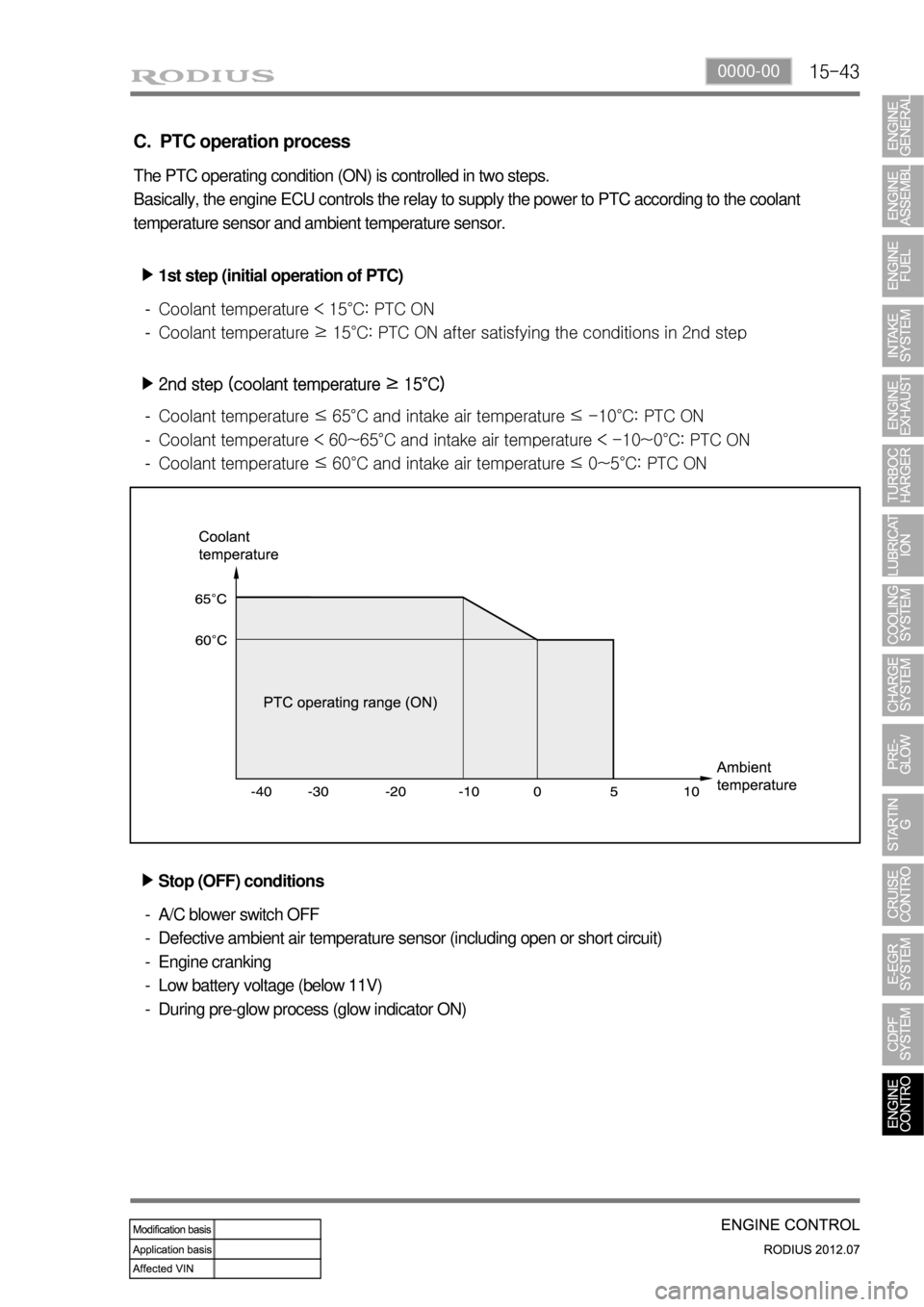
15-430000-00
C. PTC operation process
The PTC operating condition (ON) is controlled in two steps.
Basically, the engine ECU controls the relay to supply the power to PTC according to the coolant
temperature sensor and ambient temperature sensor.
1st step (initial operation of PTC) ▶
Coolant temperature < 15°C: PTC ON
<006a00960096009300880095009b0047009b008c00940097008c00990088009b009c0099008c004702fb00470058005c00b6006a006100470077007b006a00470076007500470088008d009b008c00990047009a0088009b0090009a008d00a00090009500
8e0047009b008f008c0047008a00960095008b0090009b0090>ons in 2nd step -
-
2nd step (coolant temperature ≥ 15°C) ▶
<006a00960096009300880095009b0047009b008c00940097008c00990088009b009c0099008c004702fa0047005d005c00b6006a004700880095008b004700900095009b00880092008c00470088009000990047009b008c00940097008c00990088009b00
9c0099008c004702fa004700540058005700b6006a00610047>PTC ON
<006a00960096009300880095009b0047009b008c00940097008c00990088009b009c0099008c004700630047005d005700a5005d005c00b6006a004700880095008b004700900095009b00880092008c00470088009000990047009b008c00940097008c00
990088009b009c0099008c00470063004700540058005700a5>0°C: PTC ON
<006a00960096009300880095009b0047009b008c00940097008c00990088009b009c0099008c004702fa0047005d005700b6006a004700880095008b004700900095009b00880092008c00470088009000990047009b008c00940097008c00990088009b00
9c0099008c004702fa0047005700a5005c00b6006a00610047>PTC ON -
-
-
Stop (OFF) conditions ▶
A/C blower switch OFF
Defective ambient air temperature sensor (including open or short circuit)
Engine cranking
Low battery voltage (below 11V)
During pre-glow process (glow indicator ON) -
-
-
-
-
Page 369 of 715
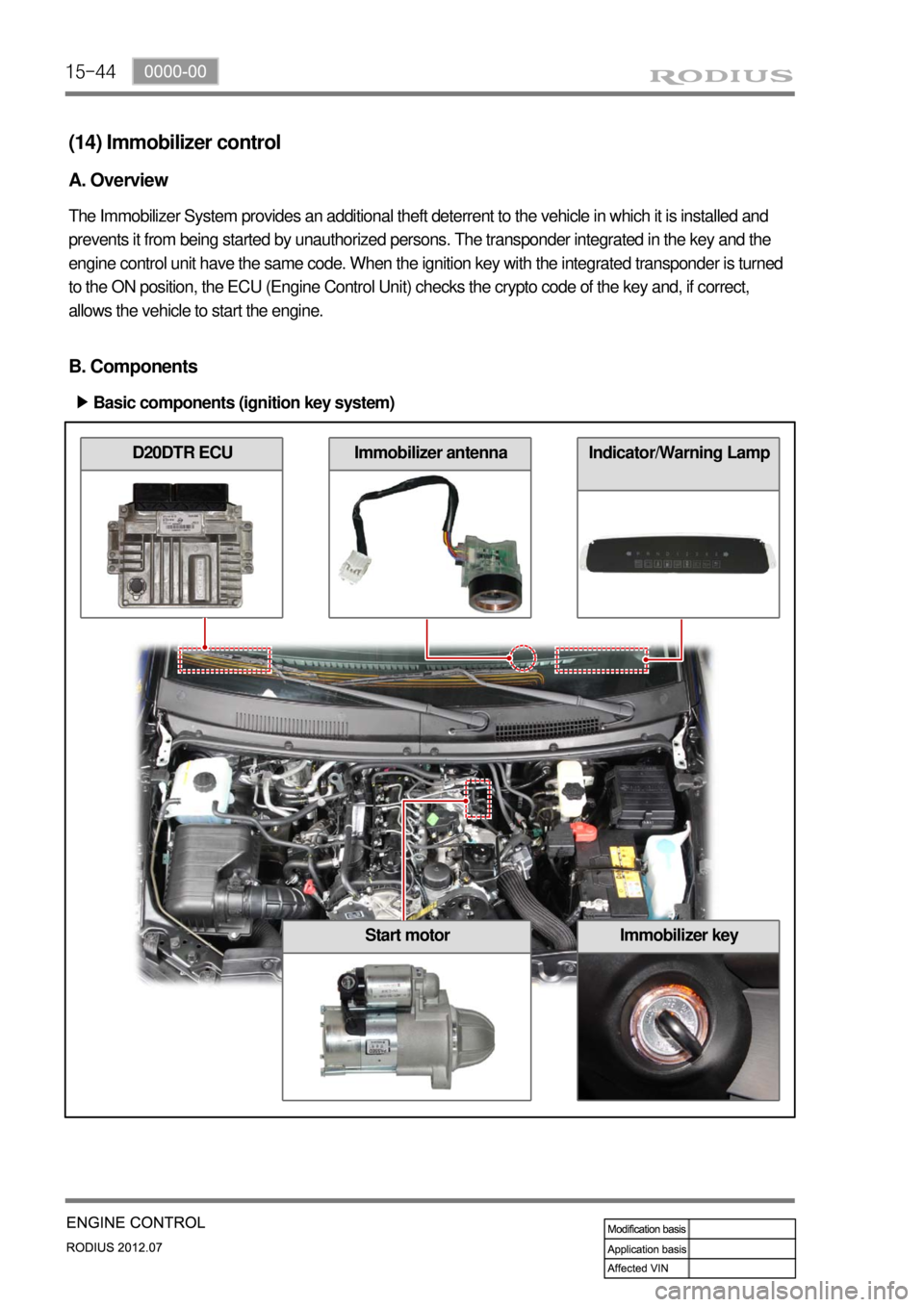
15-44
(14) Immobilizer control
A. Overview
The Immobilizer System provides an additional theft deterrent to the vehicle in which it is installed and
prevents it from being started by unauthorized persons. The transponder integrated in the key and the
engine control unit have the same code. When the ignition key with the integrated transponder is turned
to the ON position, the ECU (Engine Control Unit) checks the crypto code of the key and, if correct,
allows the vehicle to start the engine.
B. Components
Basic components (ignition key system) ▶
D20DTR ECUImmobilizer antennaIndicator/Warning Lamp
Start motorImmobilizer key
Page 370 of 715
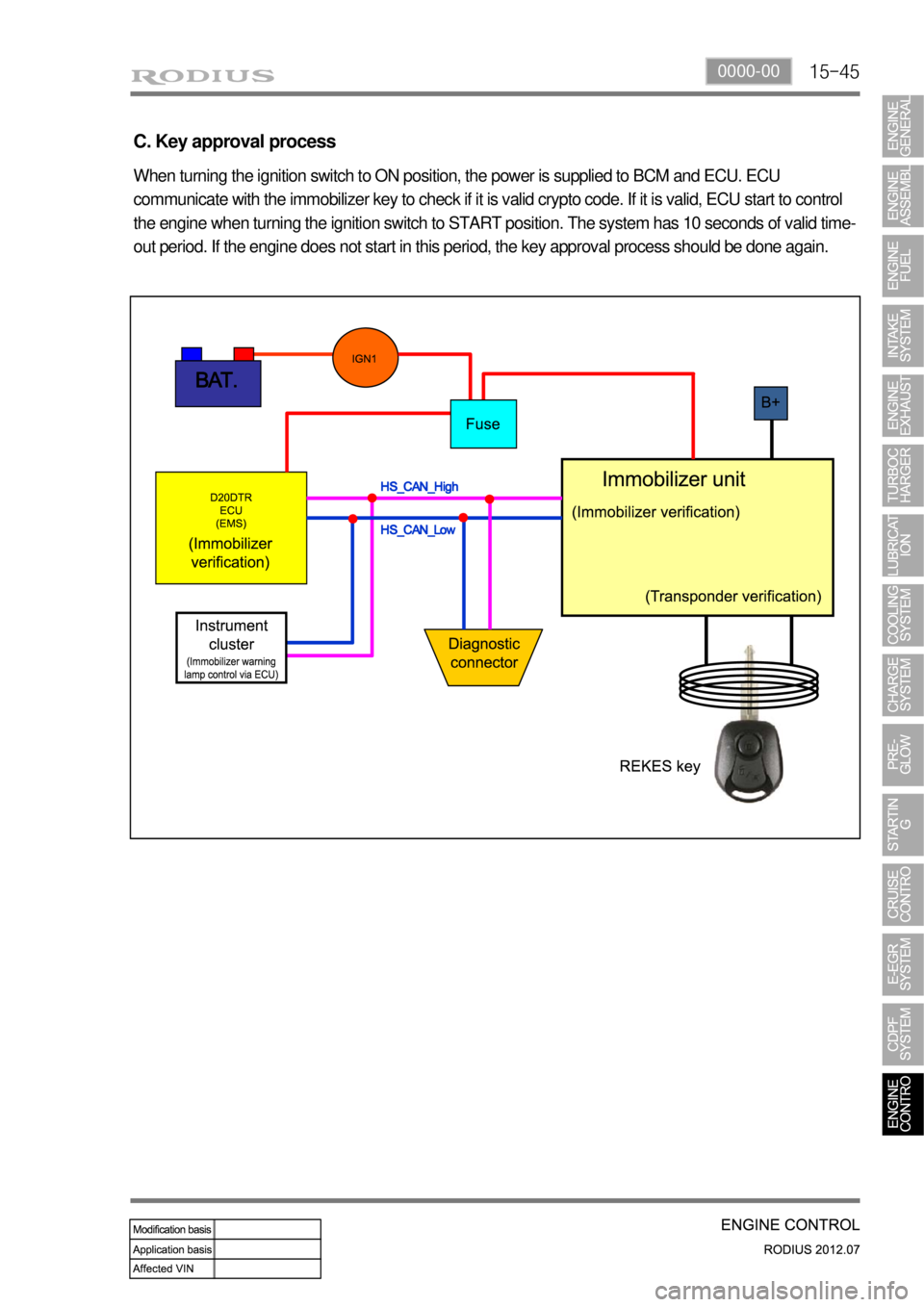
15-450000-00
C. Key approval process
When turning the ignition switch to ON position, the power is supplied to BCM and ECU. ECU
communicate with the immobilizer key to check if it is valid crypto code. If it is valid, ECU start to control
the engine when turning the ignition switch to START position. The system has 10 seconds of valid time-
out period. If the engine does not start in this period, the key approval process should be done again.
Page 371 of 715
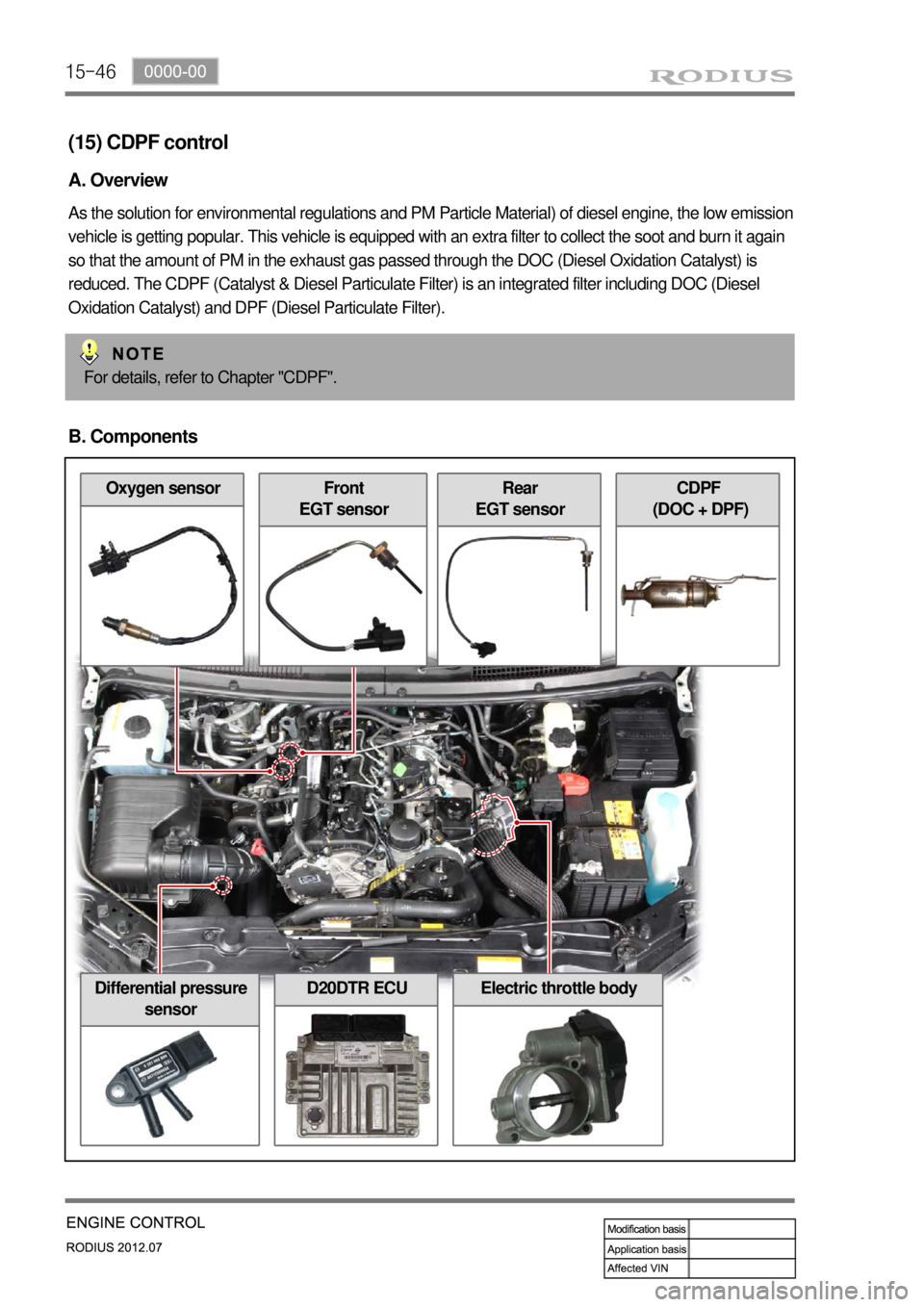
15-46
(15) CDPF control
A. Overview
As the solution for environmental regulations and PM Particle Material) of diesel engine, the low emission
vehicle is getting popular. This vehicle is equipped with an extra filter to collect the soot and burn it again
so that the amount of PM in the exhaust gas passed through the DOC (Diesel Oxidation Catalyst) is
reduced. The CDPF (Catalyst & Diesel Particulate Filter) is an integrated filter including DOC (Diesel
Oxidation Catalyst) and DPF (Diesel Particulate Filter).
For details, refer to Chapter "CDPF".
B. Components
Oxygen sensorFront
EGT sensorCDPF
(DOC + DPF)Rear
EGT sensor
Differential pressure
sensorD20DTR ECUElectric throttle body
Page 373 of 715

15-48
Rear EGT sensor:
Measure DPF temp
Diff. pres. sensor:
Measure pressure
between front side and
rear side of CDPFElectronic throttle
body: Control intake
air mass
ECU (DCM 3.7)
Injector: Control post
injection
D. Operation process
When the differential pressure sensor detects the pressure difference between the front and the rear
side of CDPF, the sensor sends signal indicating the soot is accumulated and the post injection is
performed to raise the temperature of exhaust gas. The amount of fuel injected is determined according
to the temperature of exhaust gas detected by the rear temperature sensor. If the temperature is below
600°C, the amount of fuel injected is increased to raise the tem
perature. If the temperature is over
600°C, the amount of fuel injected is decreased or not controlled. When the engine is running in
low load range, the amount of post injection and the amount of intake air are controlled. It is to raise the
temperature by increasing the amount of fuel while decreasing the amount of intake air.
Front EGT sensor:
Measure DOC temp
T-MAP sensor
Intake air
mass
Exceed PM
limitBooster
pressure/
temperaturePost injection
Control intake
air mass
Page 374 of 715

15-490000-00
E. Cautions
Use only specified Engine Oil (approved by MB Sheet 229.51) for CDPF. -
Use only specified engine oil (Low Ash Oil) ▶
The vehicle equipped with CDPF should use specific engine oil to improve the engine performance
and fuel economy, and ensure the service life of CDPF. -
Issue with normal engine oil ▶
Sulfur, one of the contents of engine oil is burned and generates soot that is not regenerated by the
DPF. This remains on the filter as ashes and keeps accumulating. Eventually, this ashes will block
the filter. -
Benefit for specified engine oil ▶
Minimized the sulfur content of engine oil which reduces the service life.
Improved fuel economy and emission level of CO2 with high performance and low viscosity.
Increased service life of engine oil with high resistance to temperature. -
-
-
Problems when using unspecified engine oil ▶
The service life of filter may be reduced by 30% or more by the ashes accumulated on the filter.
The fuel economy may be reduced because of engine rolling resistance, frequent regeneration of
DPF. -
-
These problems are also caused by oil with high sulfur content, such as tax exemption oil and
heating oil, etc. *
Page 377 of 715
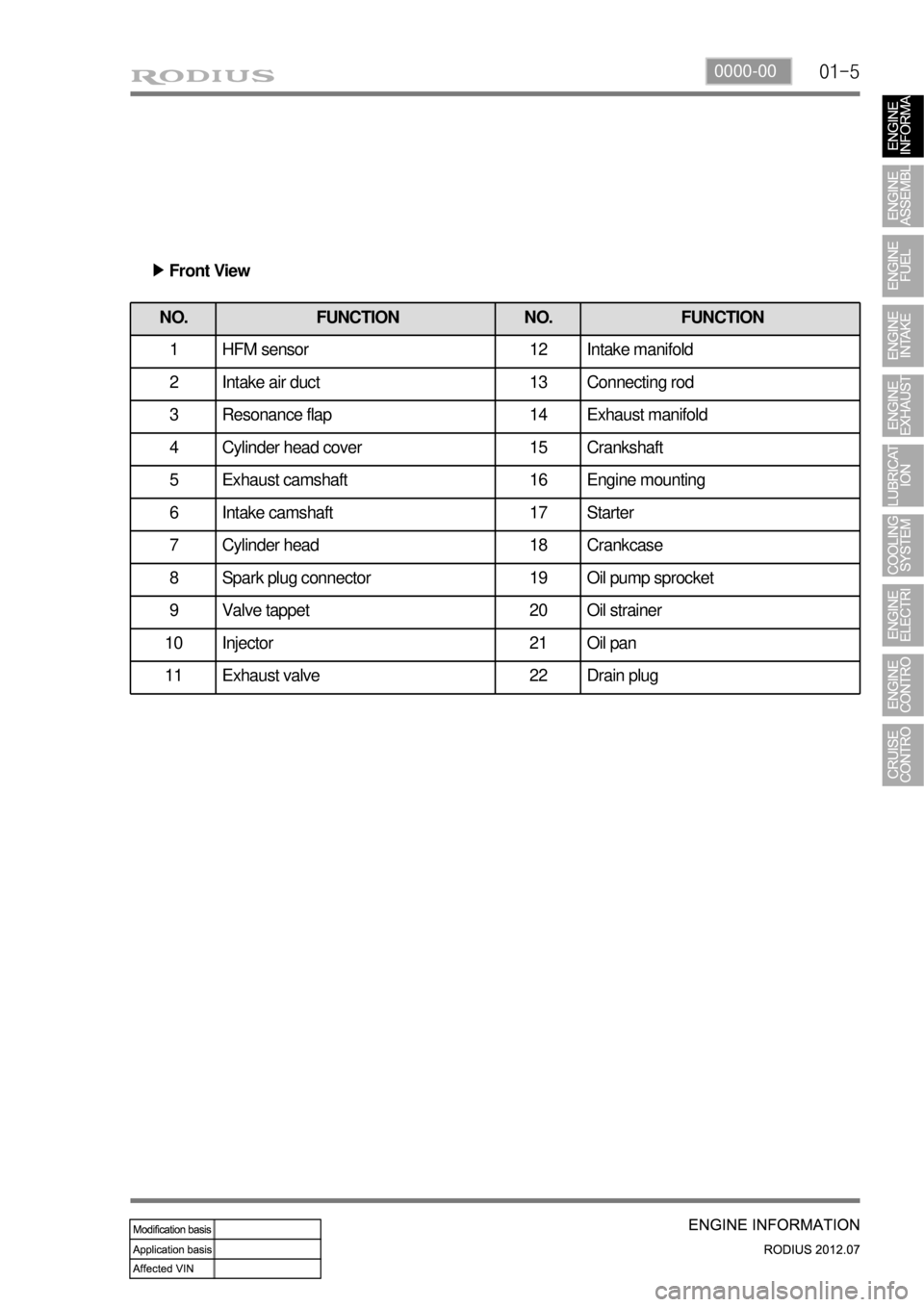
01-50000-00
NO. FUNCTION NO. FUNCTION
1 HFM sensor 12 Intake manifold
2 Intake air duct 13 Connecting rod
3 Resonance flap 14 Exhaust manifold
4 Cylinder head cover 15 Crankshaft
5 Exhaust camshaft 16 Engine mounting
6 Intake camshaft 17 Starter
7 Cylinder head 18 Crankcase
8 Spark plug connector 19 Oil pump sprocket
9 Valve tappet 20 Oil strainer
10 Injector 21 Oil pan
11 Exhaust valve 22 Drain plug
Front View ▶
Page 379 of 715
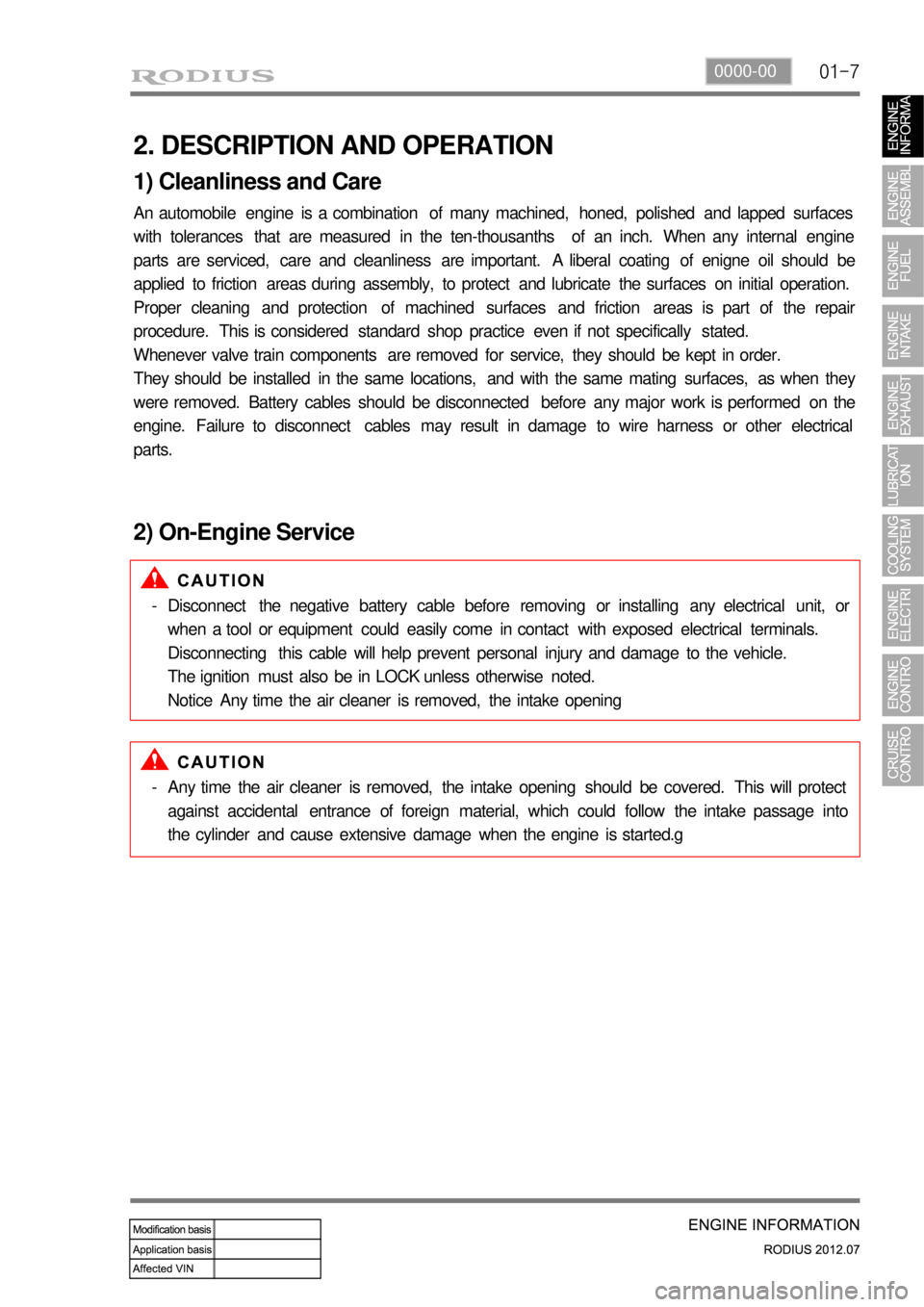
01-70000-00
2. DESCRIPTION AND OPERATION
1) Cleanliness and Care
An automobile engine is a combination of many machined, honed, polished and lapped surfaces
with tolerances that are measured in the ten-thousanths of an inch. When any internal engine
parts are serviced, care and cleanliness are important. A liberal coating of enigne oil should be
applied to friction areas during assembly, to protect and lubricate the surfaces on initial operation.
Proper cleaning and protection of machined surfaces and friction areas is part of the repair
procedure. This is considered standard shop practice even if not specifically stated.
Whenever valve train components are removed for service, they should be kept in order.
They should be installed in the same locations, and with the same mating surfaces, as when they
were removed. Battery cables should be disconnected before any major work is performed on the
engine. Failure to disconnect cables may result in damage to wire harness or other electrical
parts.
2) On-Engine Service
Disconnect the negative battery cable before removing or installing any electrical unit, or
when a tool or equipment could easily come in contact with exposed electrical terminals.
Disconnecting this cable will help prevent personal injury and damage to the vehicle.
The ignition must also be in LOCK unless otherwise noted.
Notice Any time the air cleaner is removed, the intake opening -
Any time the air cleaner is removed, the intake opening should be covered. This will protect
against accidental entrance of foreign material, which could follow the intake passage into
the cylinder and cause extensive damage when the engine is started.g -
Page 380 of 715
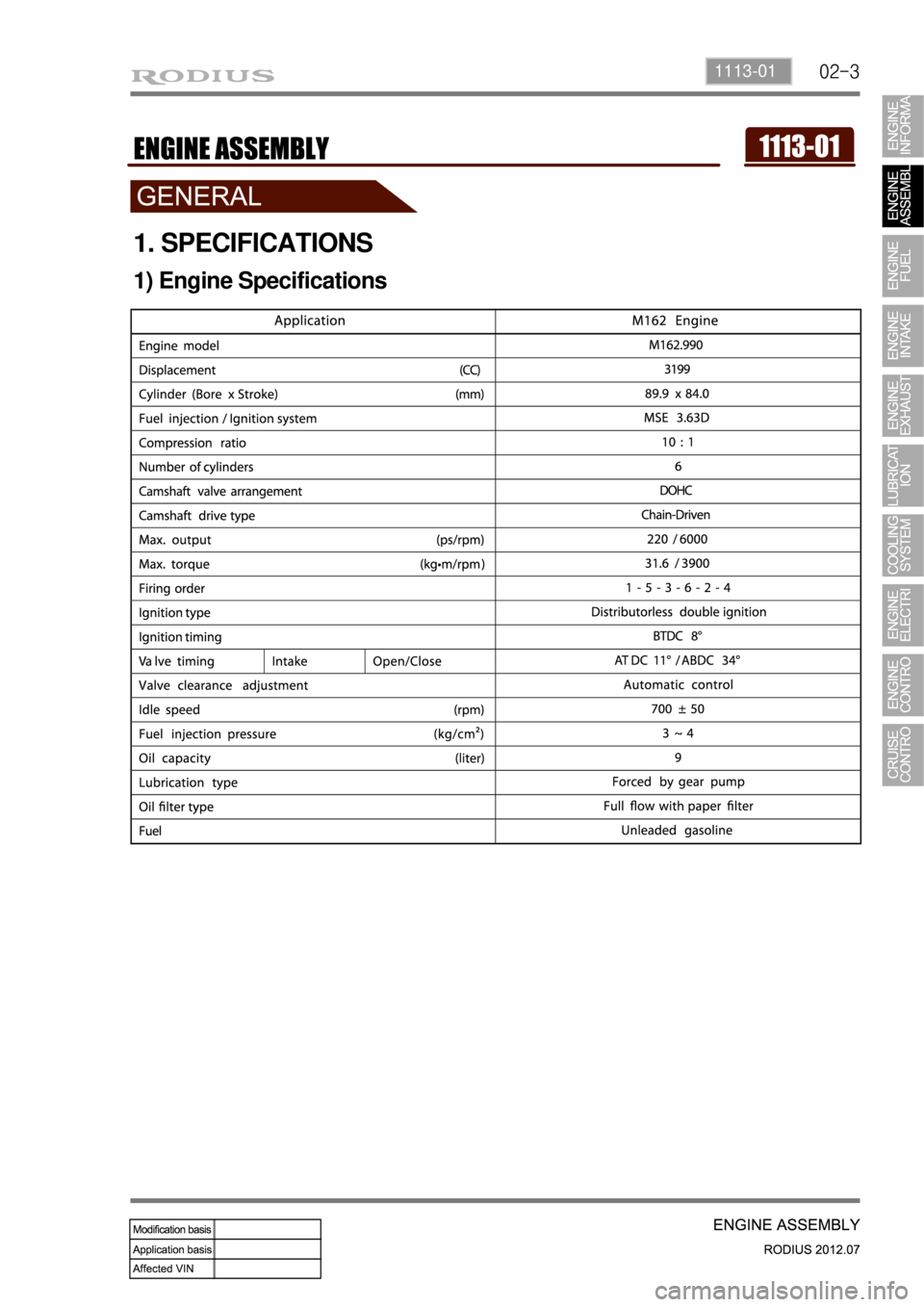
02-31113-01
1. SPECIFICATIONS
1) Engine Specifications